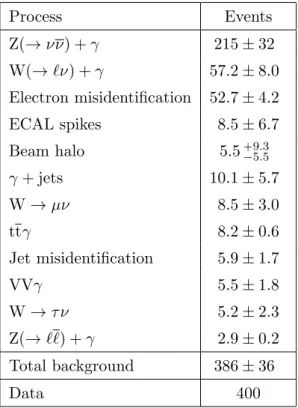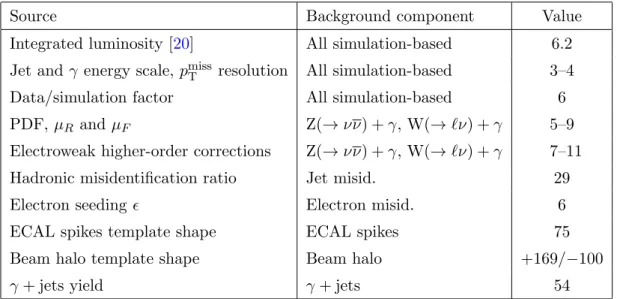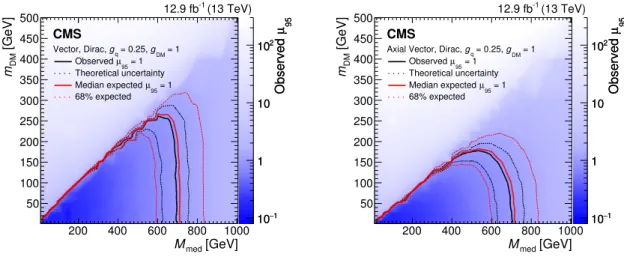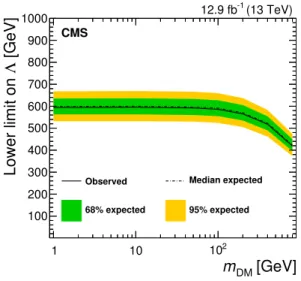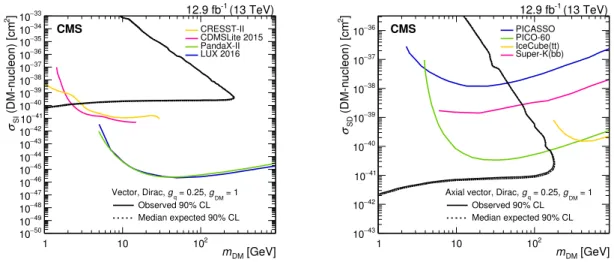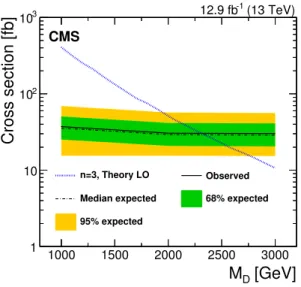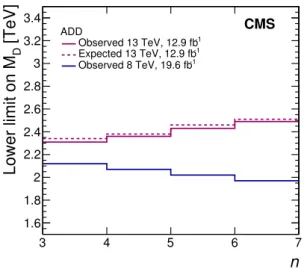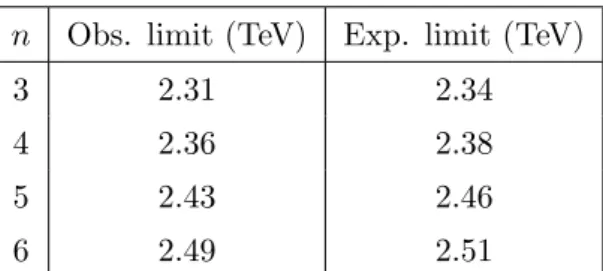JHEP10(2017)073
Published for SISSA by Springer
Received: June 12, 2017 Accepted: September 21, 2017 Published: October 11, 2017
Search for new physics in the monophoton final state in proton-proton collisions at √
s = 13 TeV
The CMS collaboration
E-mail: cms-publication-committee-chair@cern.ch
Abstract: A search is conducted for new physics in a final state containing a photon and missing transverse momentum in proton-proton collisions at √
s= 13 TeV. The data collected by the CMS experiment at the CERN LHC correspond to an integrated luminosity of 12.9 fb−1. No deviations are observed relative to the predictions of the standard model.
The results are interpreted as exclusion limits on the dark matter production cross sections and parameters in models containing extra spatial dimensions. Improved limits are set with respect to previous searches using the monophoton final state. In particular, the limits on the extra dimension model parameters are the most stringent to date in this channel.
Keywords: Beyond Standard Model, Dark matter, Hadron-Hadron scattering (experi- ments)
ArXiv ePrint: 1706.03794
JHEP10(2017)073
Contents
1 Introduction 1
2 The CMS detector and candidate reconstruction 2
3 Event selection 4
4 Signal and background modeling 5
4.1 Monte Carlo simulation for signal and background modeling 5
4.2 Background estimation using recorded data 7
5 Results and interpretation 8
5.1 Limits on simplified dark matter models 10
5.2 Limits on electroweak dark matter models 11
5.3 Limits on the ADD model 11
6 Summary 14
The CMS collaboration 19
1 Introduction
One of the most intriguing open questions in physics is the nature of dark matter (DM).
While DM is thought to be the dominant nonbaryonic contribution to the matter density of the universe [1], its detection and identification in terrestrial and spaceborne experiments remains elusive. At the CERN LHC, the DM particles may be produced in high-energy proton-proton collisions, if the DM particles interact with the standard model (SM) quarks or gluons via new couplings at the electroweak scale [2,3]. Although DM particles cannot be directly detected at the LHC, their production could be inferred from an observation of events with a large transverse momentum imbalance (missing transverse momentum,pmissT , defined in section2).
Another highly important issue is the hierarchy problem, which involves the large energy gap between the electroweak (MEW) and Planck (MPl) scales [4]. Proposed solutions to this problem include theories with large extra dimensions, such as the model of Arkani- Hamed, Dimopoulos, Dvali (ADD) [5, 6]. The ADD model postulates that there exist n compactified extra dimensions in which gravitons can propagate freely and that the true scale (MD) of the gravitational interaction in this 4+ndimensional space-time is of the same order asMEW. The compactification scaleRof the additional dimensions is related to the two gravitational scales by MPl2 ∼RnMDn+2. ForMD ∼MEW, the cases n= 1 and n= 2 are ruled out or strongly disfavored by various observations [6], while cases n≥3 remain
JHEP10(2017)073
q
¯ q
γ χ
¯ χ
q
¯ q
γ χ
¯ χ
q
¯ q
γ G
Figure 1. Leading-order diagrams of the simplified DM model (left), electroweak-DM effective interaction (center), and graviton (G) production in the ADD model (right), with a final state ofγ and largepmissT .
to be probed, for example, by collider experiments. The compactification scale R is much greater than 1/MEWfor a wide range ofn, leading to a near-continuous mass spectrum of Kaluza-Klein graviton states. Although the gravitons would not be observed directly at the LHC, their production would be manifest as events broadly distributed in pmissT .
In generic models of DM and graviton production, various SM particles can recoil against these undetected particles, producing a variety of final states with significantpmissT . The monophoton, or γ +pmissT , final state has the advantage of being identifiable with high efficiency and purity. In DM production through a vector or axial vector mediator, a photon can be radiated from incident quarks (figure 1left). Models of this process have been developed by the CMS-ATLAS Dark Matter Forum [7]. It is also possible that the DM sector couples preferentially to the electroweak sector, leading to an effective interaction qq → Z/γ∗ → γχχ [8], where χ is the DM particle (figure 1 center). In ADD graviton production, the graviton can couple directly to the photon (figure 1 right) or to a quark.
In this paper, we examine final states containing large pmissT in the presence of a photon with large transverse momentum (pT), and search for an excess of events over the SM prediction. Data collected by the CMS experiment in 2016 with an integrated luminosity of 12.9 fb−1 are analyzed. Results are interpreted in the context of these three models.
The primary irreducible background for theγ+pmissT signal is SM Z boson production associated with a photon, Z(→ νν) +γ. Other SM backgrounds include W(→ `ν) +γ (having a final state photon, and a lepton ` that escapes detection), W → `ν (where ` is misidentified as a photon), γ + jets, quantum chromodynamics (QCD) multijet events (with a jet misidentified as a photon), ttγ, VVγ (where V refers to a W or a Z boson), Z(→``) +γ, and noncollision sources, such as beam halo interactions and detector noise.
A previous search in the γ+pmissT final state using pp collisions at √
s = 8 TeV, cor- responding to an integrated luminosity of 19.6 fb−1, was reported by the CMS experiment in ref. [9]. The ATLAS experiment has also reported a similar search in 36.1 fb−1 of pp collisions at√
s= 13 TeV [10].
2 The CMS detector and candidate reconstruction
The central feature of the CMS apparatus is a superconducting solenoid of 6 m internal diameter, providing a magnetic field of 3.8 T. Within the solenoid volume are a silicon pixel and strip tracker, a lead tungstate crystal electromagnetic calorimeter (ECAL), and a brass
JHEP10(2017)073
and scintillator hadron calorimeter (HCAL), each composed of a barrel (|η| < 1.48) and two endcap (1.48<|η|<3.00) sections, whereη is the pseudorapidity. Extensive forward calorimetry complements the coverage provided by the barrel and endcap detectors. Muons are measured in gas-ionization detectors embedded in the steel flux-return yoke outside the solenoid.
An energy resolution of about 1% is reached within the barrel section of the ECAL for unconverted or late-converting photons with pT ≥60 GeV. The remaining barrel photons have a resolution of about 1.3% up to a pseudorapidity of |η| = 1, rising to about 2.5%
at |η|= 1.4 [11]. The time resolution of photons at the ECAL is <200 ps for depositions
>10 GeV. In theη–φplane, whereφ is the azimuthal angle, and for|η|<1.48, the HCAL cells map onto 5×5 arrays of ECAL crystals to form calorimeter towers projecting radially outward from the center of the detector. A more detailed description of the CMS detector, together with a definition of the coordinate system and kinematic variables, can be found in ref. [12].
Events of interest are selected using a two-tiered trigger system [13]. The first level (L1), composed of custom hardware processors, uses information from the calorimeters and muon detectors to select events at a rate of around 100 kHz within a time interval of less than 4µs. The second level, known as the high-level trigger (HLT), consists of a farm of processors running a version of the full event reconstruction software optimized for fast processing, and reduces the event rate to less than 1 kHz before data storage.
Event reconstruction is performed using a particle-flow (PF) technique [14,15], which reconstructs and identifies individual particles using an optimized combination of informa- tion from all subdetectors. The energy of charged hadrons is determined from a combina- tion of the track momentum and the corresponding ECAL and HCAL energies, corrected for the combined response function of the calorimeters. The energy of neutral hadrons is obtained from the corresponding corrected ECAL and HCAL energies. Muon identification and momentum measurements are performed by combining the information from the inner trackers and outer muon chambers.
The PF candidates in each event are clustered into jets via the anti-kt algorithm [16]
with a distance parameter of 0.4. Jet energies, computed from a simple sum of 4-momenta of the constituent PF candidates, are corrected to account for the contributions from particles associated with additional interactions within the same or nearby bunch crossings (pileup), as well as to compensate for the nonlinearities in the measured particle energies.
Jet energy corrections are obtained from simulation, and are confirmed through in situ measurements of the energy momentum balance in dijet and photon + jet events.
The uncorrected missing transverse momentum vector (~pTmiss) is defined as the negative vector sum of the transverse momenta of all PF candidates in an event. This quantity is adjusted with the difference of uncorrected and corrected jets for a consistent and more accurate missing momentum measurement [17]. The magnitude of ~pTmiss is referred to as the missing transverse momentum, pmissT .
The reconstruction of photons and electrons begins with the identification of clusters of energy deposited in the ECAL with little or no observed energy in the corresponding HCAL region. For each candidate cluster, the reconstruction algorithm searches for hits in
JHEP10(2017)073
the pixel and strip trackers that can be associated with the cluster. Such associated hits are called electron seeds, and are used to initiate a special track reconstruction based on a Gaussian sum filter [18,19], which is optimized for electron tracks. A “seed veto” removes photon candidates with an associated electron seed.
Selections based on calorimetric information and isolation are applied to distinguish photons from electromagnetic (EM) showers caused by hadrons. The calorimetric require- ments for photons comprise H/E < 0.05 and σηη < 0.0102, where H/E is the ratio of hadronic to EM energy deposition. The variableσηη, described in detail in ref. [11], repre- sents the width of the electromagnetic shower in theηdirection, which is generally larger in showers from hadronic activity. For a photon candidate to be considered as isolated, scalar sums of the transverse momenta of PF charged hadrons, neutral hadrons, and photons within a cone of ∆R=√
(∆η)2+ (∆φ)2<0.3 around the candidate photon must individ- ually fall below the bounds defined for 80% signal efficiency. Only the PF candidates that do not overlap with the EM shower of the candidate photon are included in the isolation sums.
Each PF charged hadron is reconstructed from a track and can be associated with an interaction vertex it originates from. Therefore, the isolation sum over PF charged hadrons should be computed using only the candidates sharing an interaction vertex with the photon candidate. However, because photon candidates are not reconstructed from tracks, their vertex association is ambiguous. When an incorrect vertex is assigned, photon candidates that are not isolated can appear otherwise. To mitigate the rate for accepting nonisolated candidates as photon candidates, the maximum charged hadron isolation value over all vertex hypotheses (worst isolation) is used.
Another consequence of calorimetry-driven reconstruction is that stray ECAL clus- ters produced by mechanisms other than pp collisions can be misidentified as photons.
In particular, beam halo muons that accompany proton beams and penetrate the detec- tor longitudinally, and the interaction of particles in the ECAL photodetectors (“ECAL spikes”) have been found to produce spurious photon candidates at nonnegligible rates.
To reject these backgrounds, the ECAL signal in the seed crystal of the photon cluster is required to be within ±3 ns of the arrival time expected for particles originating from a collision. In addition, the candidate cluster must comprise more than a single ECAL crystal. Furthermore, the maximum of the total energy along all possible paths of beam halo particles passing through the cluster is calculated for each photon candidate. This quantity, referred to as the halo total energy, is required to be below a threshold defined to retain 95% of the true photons, while rejecting 80% of the potential halo clusters.
3 Event selection
The integrated luminosity of the analyzed data sample, derived from a preliminary mea- surement using the method described in [20], is (12.9±0.8) fb−1. The data sample is collected with a single-photon trigger that requires at least one photon candidate with pT > 165 GeV. The photon candidate must have H/E < 0.1, to reject jets. The photon energy reconstructed in the trigger is less precise relative to that derived later in the of- fline selection. Therefore, the thresholds in the trigger on both H/E and pγT, where pγT is
JHEP10(2017)073
the photon pT, are less restrictive than their offline counterparts. The trigger efficiency is measured to be about 98% for events passing the analysis selection with pγT >175 GeV.
From the recorded data, events are selected by requiring pmissT >170 GeV and at least one photon with pγT > 175 GeV in the fiducial region of the ECAL barrel (|η| < 1.44).
Events are rejected if the minimum opening angle between ~pTmiss and any of the four high- est transverse momenta jets, ∆φ(~pTmiss, ~pTjet), is less than 0.5. This requirement significantly suppresses spuriouspmissT backgrounds from mismeasured jets. Only jets withpT>30 GeV and |η|<5 are considered in the ∆φ(~pTmiss, ~pTjet) calculation. The candidate photon trans- verse momentum vector and ~pTmiss must be separated by more than 2 radians. Finally, to reduce the contribution from the W(→ `ν) +γ process, events are vetoed if they contain an electron or a muon with pT>10 GeV that is separated from the photon by ∆R >0.5.
4 Signal and background modeling
The SM backgrounds and signal are modeled using both simulated events and recorded data. The two methods are described in the following sections.
4.1 Monte Carlo simulation for signal and background modeling
Monte Carlo (MC) simulation is used to model the signal and some classes of SM back- ground events. For the SM backgrounds, the primary hard interaction is simulated using the MadGraph5 amc@nlo version 2.2.2 [21] or pythia8.212 [22] generators employing the NNPDF 3.0 [23] leading-order (LO) parton distribution function (PDF) set at the strong coupling value αS = 0.130. Parton showering and hadronization are provided in pythia8.212 through the underlying-event tune CUETP8M1 [24]. Multiple minimum-bias events are overlaid on the primary interaction to model the distribution of pileup in data.
Generated particles are processed through the full Geant4-based simulation of the CMS detector [25,26].
For the DM signal hypothesis, MC simulation samples are produced with Mad- Graph5 amc@nlo 2.2.2, requiring pγT > 130 GeV and |ηγ| < 2.5. A large number of DM simplified model samples are generated, varying the masses of the mediator and DM particles. Similarly, electroweak-DM effective interaction samples are generated with a range of dark matter masses. For the ADD hypothesis, events are generated using py- thia8.212, requiring pγT > 130 GeV, with no restriction on the photon pseudorapidity.
Samples are prepared in a grid of number of extra dimensions and MD. The efficiency of the full event selection on these signal models ranges between 0.12 and 0.27 for the DM simplified models, 0.42 and 0.45 for electroweak DM production, and 0.22 and 0.28 for the ADD model, depending on the parameters of the models.
Predictions for signal and background MC yields are rescaled by an overall correction factor (ρ) that accounts for the differences in event selection efficiency between data and simulation. The value of ρ = 0.94±0.06 reflects the product of three correction factors:
0.94±0.01 for photon identification and isolation, 1.00±0.01 for the electron seed veto, and 1.00±0.06 for the combination of the worst isolation, the halo total energy requirement,
JHEP10(2017)073
and the lepton veto. The selection efficiencies are measured in data using the tag-and- probe technique [27]. Events with Z →ee decays are employed for measuring the photon identification and isolation efficiencies, while a Z →µµγ sample is utilized to extract the other efficiency factors [28].
The most significant SM backgrounds in this search are from the associated production of a Z or W boson with a high-energy photon, denoted as Z(→νν) +γ and W(→`ν) +γ.
When the Z boson decays into a neutrino-antineutrino pair, the final state exhibits a high- pT photon and largepmissT . Similarly, if the W boson decays into a lepton-neutrino pair and the lepton escapes detection, the event appears to be γ+pmissT . Together, these processes account for approximately 70% of the SM background, with 50% from Z(→νν) +γ alone.
The estimation of Z(→νν)+γand W(→`ν)+γbackgrounds is based onMadGraph5 amc@nlo simulations at LO in QCD and with up to two additional partons in the final state. In addition to the selection efficiency correction factorρ, these samples are weighted event-by-event with the product of two factors. The first factor matches the distribution of the generator-level pγT to that calculated at next-to-next-to-leading order (NNLO) in QCD using theDYResprogram [29]. The second factor, taken from refs. [30,31], further corrects the backgrounds to account for next-to-leading order (NLO) electroweak effects.
The estimated contributions from the Z(→ νν) +γ and W(→ `ν) +γ processes after applying the selections in section 3 are given in table 1, and amount to 215±32 and 57.2±8.0 events, respectively. Statistical and systematic uncertainties are combined in quadrature. The statistical uncertainty is subdominant and is due to the finite size of the simulation sample. Systematic uncertainties in the estimated Z(→νν)+γ and W(→`ν)+γ yields have four contributions and are summarized in table 2. The first is associated with the PDF and the choice of renormalization and factorization scales (µR and µF) used in generating the events. The relative uncertainty from these sources are 5.4% and 8.9%
in the Z(→ νν) +γ and W(→ `ν) +γ yields, respectively. Uncertainty from the PDF is evaluated by varying the weight of each event based on the standard deviation of the event weight distribution as given by the NNPDF set. Uncertainties from the choice of µR and µF are evaluated by setting the scales to twice or half the nominal values and taking the minima and maxima of the resulting event weights. Second, the uncertainty due to missing higher-order electroweak corrections is taken as the magnitude of the NLO correction. The uncertainty from this source is 11% for the Z(→νν) +γ process and 7%
for W(→ `ν) +γ. The third uncertainty is on the selection efficiency correction factor ρ, with the main contribution from the statistical uncertainties in individual efficiency measurements. A fourth uncertainty is assigned to cover the uncertainties in the jet energy scale [32], photon energy scale [33], pileup, and the scale and resolution in pmissT . The combined relative uncertainties from the third and fourth categories in the Z(→ νν) +γ and W(→`ν) +γ yields are 6% and 6.2%, respectively.
To validate the predictions from simulation, observed and MC simulated data are compared in two control regions. One region consists of events with two same-flavor leptons of opposite-charge and a photon, which is dominated by the Z(→ ``) +γ process. The photon is selected by criteria identical to those used in the signal candidate event selection, while the leptons are required to have pT >10 GeV and the dilepton invariant mass must
JHEP10(2017)073
lie between 60 and 120 GeV. Furthermore, the recoil U`` = |~pTmiss +~pT` +~pT`| [27] must be greater than 170 GeV to emulate the pmissT in Z(→ νν) + γ events. In addition to simulated Z(→``) +γ events, MC samples of ttγ, Z(→ ``) + jets, and multiboson events are also considered. In total, 68.1±3.8 events are predicted in the dilepton control region, and 64 events are observed. The dominant uncertainty is theoretical. Using the ratio of acceptances between the Z(→νν) +γ and Z(→``) +γ simulations, this validation is used to predict the Z(→νν) +γ contribution to the candidate sample of 242±35, which is in agreement with the purely simulation-based prediction given previously. The uncertainty in this prediction is mainly due to the limited event yields in the control samples.
The second region is defined by requirements of exactly one electron or muon with pT > 30 GeV, one photon with pT > 175 GeV, pmissT > 50 GeV, and U` = |~pTmiss+~pT`| >
170 GeV [17]. This region is dominated by W(→`ν) +γ production. A total of 108 events are observed in this region, where 10.6±1.3 non-W +γ background events are expected.
The ratio of the acceptance for W +γ events where the lepton is missed, compared to the acceptance for events where it is identified is estimated from simulation, and is multiplied with the background-subtracted observed yield of this control region. The product, 69.2± 7.6, gives a prediction of W(→`ν)+γ contribution in the signal region that is in agreement with the simulation-based estimate. As with the Z(→ ``) +γ estimate, the dominant uncertainty is theoretical.
The SM ttγ, VVγ, Z(→ ``) +γ, W → `ν, and γ+ jets processes are minor (∼10%) backgrounds in the signal region. Although Z(→``) +γandγ+ jets do not involve high-pT invisible particles, the former can exhibit largepmissT when the leptons are not reconstructed, and the latter when jet energy is severely mismeasured. The estimates for all five processes are taken from MadGraph5 amc@nlosimulations at leading order in QCD.
4.2 Background estimation using recorded data
An important background consists of W→eν events in which the electron is misidentified as a photon. The misidentification occurs because of an inefficiency in seeding electron tracks. A seeding efficiency of = 0.977±0.002 for electrons with pT > 160 GeV is measured in data using a tag-and-probe technique in Z → ee events, and is verified with MC simulation. Misidentified electron events are modeled by a proxy sample of electron events, defined in data by requiring an ECAL cluster with a pixel seed. The proxy events must otherwise pass the same criteria used to select signal candidate events. The number of electron proxy events is then scaled by (1−)/ to yield an estimated contribution of 52.7±4.2 events from electron misidentification. The dominant uncertainty in this estimate is the statistical uncertainty in the measurement of .
Electromagnetic showers from hadronic activity can also mimic a photon signature.
This process is estimated by counting the numbers of events in two different subsets of a low- pmissT multijet data sample. The first subset consists of events with a photon candidate that satisfies the signal selection criteria. These events contain both true photons and jets that are misidentified as photons. The second subset comprises events with a candidate photon that meets less stringent shower-shape requirements and inverted isolation criteria with re- spect to the signal candidates. Nearly all of the candidate photons in these events arise from
JHEP10(2017)073
jet misidentification. The hadron misidentification ratio is defined as the ratio between the number of the misidentified events in the first subset to the total number of events in the second subset. The numerator is estimated by fitting the shower shape distribution of the photon candidate in the first subset with template distributions. For true photons, a tem- plate for the shower width is formed using simulatedγ+jets events. For jets misidentified as photons, the template is obtained from a sample selected by inverting the charged-hadron isolation and removing the shower-shape requirement entirely. Once the hadron misidenti- fication ratio is computed, it is multiplied by the number of events in the high-pmissT control sample with a photon candidate that satisfies the conditions used to select the second subset of the low-pmissT control sample. The product, 5.9±1.7 events, is the estimate of the contri- bution of jet misidentification background in the signal region. The dominant uncertanty is systematic, and accounts for the effects of the fitting procedure, sample purity, photon candidate definition of the control samples, and the sample bias in the jet composition.
Finally, backgrounds from beam halo and spikes in the ECAL are estimated from fits of the angular and timing distributions of the calorimeter clusters. Energy clusters in the ECAL due to beam halo muons are observed to concentrate around φ∼0 andπ, while all other processes (collision-related processes and ECAL spikes) produce photon candidates that are uniformly distributed in φ. The distribution of the cluster seed time provides a cross-check on this background estimate and an independent means to estimate the ECAL spikes contribution. Exploiting these features, a two-component fit of the φ distribution with beam halo and uniform templates, and a three-component fit of the cluster seed time using the halo, spike, and prompt-photon templates are performed. In both fits, the halo template is obtained by requiring high halo total energy for candidate-like photon candidates. The timing distribution of the spike background is obtained by inverting the shower shape requirement in the candidate photon selection. The results of the two fits are combined into an uncertainty-weighted average. Beam halo and spike backgrounds of 5.5+9.3−5.5and 8.5±6.7 events, respectively, are predicted, where the dominant uncertainty is statistical.
5 Results and interpretation
The estimated number of events and the associated uncertainty for each background process are given in table1. A total of 400 events are observed in data, which is in agreement with the total expected SM background of 386±36 events.
Distributions of pγTandpmissT for the selected candidate events are shown in figure2to- gether with their respective estimated background distributions. A summary of the system- atic uncertainties for the background estimates is given in table 2. The quoted systematic uncertainties in table2 follow the signal and background modeling discussion in section4.
No excess of data with respect to the SM prediction is observed and limits are set on the aforementioned DM and ADD models. The evaluation of systematic uncertainties for the simulated signal follows the same procedures used for simulated backgrounds (section 4).
For each signal model, a 95% confidence level (CL) cross section upper bound is obtained utilizing the asymptotic CLs criterion [34–37]. In this method, a Poisson likelihood for
JHEP10(2017)073
Process Events
Z(→νν) +γ 215±32
W(→`ν) +γ 57.2±8.0
Electron misidentification 52.7±4.2
ECAL spikes 8.5±6.7
Beam halo 5.5+9.3−5.5
γ+ jets 10.1±5.7
W→µν 8.5±3.0
ttγ 8.2±0.6
Jet misidentification 5.9±1.7
VVγ 5.5±1.8
W→τ ν 5.2±2.3
Z(→``) +γ 2.9±0.2
Total background 386±36
Data 400
Table 1. Summary of estimated background and observed candidate events. The quoted uncertain- ties for the background estimates are obtained by adding the systematic and statistical uncertainties in quadrature.
200 400 600 800 1000
Events/GeV
10-3
10-2
10-1
1 10 102
103
(13 TeV) 12.9 fb-1
CMS
γ ν ν
→
Zγ Wγ→ lνγ
MisID γ
Electron→ Spikes
Beam-halo Jet→γ MisID
Others VVγ
Bkg. uncertainty ADD, MD=2TeV, n=5
)=(200,50) GeV ,mDM
DM AV (Mmed Data
[GeV]
γ
pT 200 300 400 500 600 700 800 900 1000
Data/SM
0 1 2 3
4
200 400 600 800 1000
Events/GeV
10-3
10-2
10-1
1 10 102
103
(13 TeV) 12.9 fb-1
CMS
γ ν ν
→
Zγ Wγ→ lνγ
MisID γ
Electron→ Spikes
Beam-halo Jet→γ MisID
Others VVγ
Bkg. uncertainty ADD, MD=2TeV, n=5
)=(200,50) GeV ,mDM
DM AV (Mmed Data
[GeV]
miss
pT
200 300 400 500 600 700 800 900 1000
Data/SM
0 1 2 3
Figure 2. ThepγT(left) andpmissT (right) distributions for the candidate sample, compared with esti- mated contributions from SM backgrounds. In the legends, “others” includes the contribution from γ+ jets, W→`ν, Z(→``) +γ, and ttγbackgrounds. The background uncertainties include statisti- cal and systematic components. The last bin includes the overflow. The lower panel shows the ratio of data and SM background predictions, where the hatched band shows the systematic uncertainty.
JHEP10(2017)073
Source Background component Value
Integrated luminosity [20] All simulation-based 6.2 Jet and γ energy scale, pmissT resolution All simulation-based 3–4
Data/simulation factor All simulation-based 6
PDF, µR and µF Z(→νν) +γ, W(→`ν) +γ 5–9
Electroweak higher-order corrections Z(→νν) +γ, W(→`ν) +γ 7–11
Hadronic misidentification ratio Jet misid. 29
Electron seeding Electron misid. 6
ECAL spikes template shape ECAL spikes 75
Beam halo template shape Beam halo +169/−100
γ+ jets yield γ+ jets 54
Table 2. Summary of relative systematic uncertainties (%) for different background estimates.
The middle column indicates the component of the estimated SM background that is affected by each uncertainty.
the observed number of events is maximized under different signal strength hypotheses, taking the systematic uncertainties as nuisance parameters that modify the signal and background predictions. Each nuisance parameter is assigned a log-normal probability distribution, using the systematic uncertainty value as the width. The best fit background predictions differ from the original by at most 4%. Confidence intervals are drawn by comparing these maximum likelihood values to those computed from background-only and signal-plus-background pseudo-data.
5.1 Limits on simplified dark matter models
The simplified DM models proposed by the LHC Dark Matter Forum [7] are designed to facilitate the comparison and translation of various DM search results. In the models considered in this analysis, Dirac DM particles couple to a vector or axial-vector mediator, which in turn couples to the SM quarks. Model points are identified by a set of four parameters: the DM massmDM, the mediator massMmed, the universal mediator coupling to quarks gq, and the mediator coupling to DM particles gDM. In this analysis, we fix the values of gq and gDM to 0.25 and 1.0, respectively, and scan the Mmed–mDM plane [38].
The search is not yet sensitive to the spin-0 mediator models defined in ref. [7].
Figure3shows the 95% CL cross section upper limits with respect to the corresponding theoretical cross section (µ95 = σ95%/σtheory) for the vector and axial-vector mediator scenarios, in the Mmed–mDM plane. The solid red (lighter) and black (darker) curves are the expected and observed contours ofµ95= 1 (exclusion contour). The region withµ95<1 is excluded under nominalσtheoryhypotheses. The uncertainty in the expected upper limit includes the experimental uncertainties. The uncertainty in the theoretical cross section is translated to the uncertainty in the observed exclusion contour. While there is little difference in kinematic properties between the two scenarios, the production cross section
JHEP10(2017)073
95µObserved
1
10−
1 10 102
95µObserved
1
10−
1 10 102
(13 TeV) 12.9 fb-1
CMS
DM = 1 = 0.25, g gq
Vector, Dirac,
95 = 1 Observed µ Theoretical uncertainty
95 = 1 Median expected µ 68% expected
[GeV]
Mmed
200 400 600 800 1000 [GeV]DMm
50 100 150 200 250 300 350 400 450
500 95
µObserved
1
10−
1 10 102
95µObserved
1
10−
1 10 102
(13 TeV) 12.9 fb-1
CMS
DM = 1 = 0.25, g gq
Axial Vector, Dirac,
95 = 1 Observed µ Theoretical uncertainty
95 = 1 Median expected µ 68% expected
[GeV]
Mmed
200 400 600 800 1000 [GeV]DMm
50 100 150 200 250 300 350 400 450 500
Figure 3. The ratio of 95% CL cross section upper limits to theoretical cross section (µ95), for DM simplified models with vector (left) and axial-vector (right) mediators, assuminggq= 0.25 and gDM = 1. Expected and observed µ95 = 1 contours are overlaid. The region below the observed contour is excluded.
for heavier dark matter in the vector mediator scenario tends to be higher [7], and therefore the exclusion region broader. For the simplified DM models considered, mediator masses of up to 700 GeV are excluded for small mDM values.
The exclusion contours in figure 3 are also translated into the σSI/SD–mDM plane, where σSI/SD are the spin-independent/dependent DM-nucleon scattering cross sections.
The translation and presentation of the result follows the prescription given in ref. [38]. In particular, to enable a direct comparison with results from direct detection experiments, these limits are calculated at 90% CL [7]. When compared to the direct detection exper- iments, the limits obtained from this search provide stronger constraints for dark matter masses less than 2 GeV, assuming spin-independent scattering, or less than 200 GeV, for spin-dependent scattering.
5.2 Limits on electroweak dark matter models
The DM effective field theory (EFT) model contains a dimension-7 contact interaction of type γγχχ [8]. The interaction is described by four parameters: the coupling to photons (parametrized in terms of coupling strengths k1 and k2), the DM mass mDM, and the suppression scale Λ. Since the interaction cross section is directly proportional to Λ−6, cross section upper limits are translated into lower limits on Λ, assuming k1 = k2 = 1.
The expected and observed lower limits on Λ as a function of mDM are shown in figure 5.
Values of Λ up to 600 GeV are excluded at 95% CL.
5.3 Limits on the ADD model
Figure 6shows the upper limit and the theoretically calculated ADD graviton production cross section for n = 3 extra dimensions, as a function of MD. Lower limits on MD for various values ofnextra dimensions are summarized in table3, and in figure7are compared
JHEP10(2017)073
CRESST-II CDMSLite 2015 PandaX-II LUX 2016
DM = 1 = 0.25, g gq
Vector, Dirac, Observed 90% CL Median expected 90% CL
(13 TeV) 12.9 fb-1
CMS
[GeV]
mDM
1 10 102
]2 (DM-nucleon) [cmSIσ
50
10− 49
10− 48
10− 47
10− 46
10− 45
10− 44
10− 43
10− 42
10− 41
10− 40
10− 39
10− 38
10− 37
10− 36
10− 35
10− 34
10− 33
10−
DM = 1 = 0.25, g gq
Axial vector, Dirac, Observed 90% CL Median expected 90% CL
PICASSO PICO-60 IceCube(tt) Super-K(bb)
(13 TeV) 12.9 fb-1
CMS
[GeV]
mDM
1 10 102
]2 (DM-nucleon) [cmSDσ
43
10− 42
10− 41
10− 40
10− 39
10− 38
10− 37
10− 36
10−
Figure 4. The 90% CL exclusion limits on the χ-nucleon spin-independent (left) and spin- dependent (right) scattering cross sections involving vector and axial-vector operators, respectively, as a function of themDM. Simplified model DM parameters ofgq = 0.25 andgDM= 1 are assumed.
The region to the upper left of the contour is excluded. On the plots, the median expected 90% CL curve overlaps the observed 90% CL curve. Also shown are corresponding exclusion contours, where regions above the curves are excluded, from the recent results by CDMSLite [39], LUX [40], Pan- daX [41], CRESST-II [42], PICO-60 [43], IceCube [44], PICASSO [45] and Super-Kamiokande [46]
Collaborations.
[GeV]
mDM
1 10 102
[GeV]ΛLower limit on
100 200 300 400 500 600 700 800 900 1000
Observed Median expected 68% expected 95% expected
(13 TeV) 12.9 fb-1
CMS
Figure 5. The 95% CL expected and observed lower limits on Λ as a function of mDM, for a dimension-7 operator EFT model assumingk1=k2= 1.
JHEP10(2017)073
[GeV]
MD
1000 1500 2000 2500 3000
Cross section [fb]
1 10 102
103
n=3, Theory LO Observed Median expected 68% expected 95% expected
(13 TeV) 12.9 fb-1
CMS
Figure 6. The 95% CL upper limits on the ADD graviton production cross section, as a function ofMD forn= 3 extra dimensions.
n
3 4 5 6 7
[TeV] DLower limit on M
1.6 1.8 2 2.2 2.4 2.6 2.8 3 3.2 3.4
ADDObserved 13 TeV, 12.9 fb-1
Expected 13 TeV, 12.9 fb-1
Observed 8 TeV, 19.6 fb-1
CMS
Figure 7. Lower limit on MD as a function ofn, the number of ADD extra dimensions.
to CMS results at √
s = 8 TeV [9]. Because the graviton production cross section scales as En/MDn+2 [47], where E is the typical energy of the hard scattering, MD can be an increasing or decreasing function of n for a fixed cross section value, approaching E as n → ∞. Note that the value of E is dependent on the center-of-mass energy of the pp collision, and is∼2 TeV for√
s= 8 TeV and ∼3 TeV for√
s= 13 TeV. Values ofMD up to 2.49 TeV forn= 6 are excluded by the current analysis.
JHEP10(2017)073
n Obs. limit (TeV) Exp. limit (TeV)
3 2.31 2.34
4 2.36 2.38
5 2.43 2.46
6 2.49 2.51
Table 3. The 95% CL observed and expected lower limits onMD as a function ofn, the number of ADD extra dimensions.
6 Summary
Proton-proton collisions producing large missing transverse momentum and a high trans- verse momentum photon have been investigated to search for new phenomena, using a data set corresponding to 12.9 fb−1 of integrated luminosity recorded at √
s= 13 TeV at the CERN LHC. No deviations from the standard model predictions are observed. Con- straints are set on the production cross sections for dark matter and large extra dimension gravitons at 95% confidence level, which are then translated to limits on the parameters of the individual models. For the simplified dark matter production models considered, the search excludes mediator masses of up to 700 GeV for low-mass dark matter. For an effective dimension-7 photon-dark matter contact interaction, values of Λ up to 600 GeV are excluded. For the ADD model with extra spatial dimensions, values of the funda- mental Planck scale up to 2.31–2.49 TeV, depending on the number of extra dimensions, are excluded. These are the most stringent limits in the ADD model to date using the monophoton final state.
Acknowledgments
We congratulate our colleagues in the CERN accelerator departments for the excellent performance of the LHC and thank the technical and administrative staffs at CERN and at other CMS institutes for their contributions to the success of the CMS effort. In ad- dition, we gratefully acknowledge the computing centres and personnel of the Worldwide LHC Computing Grid for delivering so effectively the computing infrastructure essential to our analyses. Finally, we acknowledge the enduring support for the construction and operation of the LHC and the CMS detector provided by the following funding agencies:
BMWFW and FWF (Austria); FNRS and FWO (Belgium); CNPq, CAPES, FAPERJ, and FAPESP (Brazil); MES (Bulgaria); CERN; CAS, MoST, and NSFC (China); COL- CIENCIAS (Colombia); MSES and CSF (Croatia); RPF (Cyprus); SENESCYT (Ecuador);
MoER, ERC IUT, and ERDF (Estonia); Academy of Finland, MEC, and HIP (Finland);
CEA and CNRS/IN2P3 (France); BMBF, DFG, and HGF (Germany); GSRT (Greece);
OTKA and NIH (Hungary); DAE and DST (India); IPM (Iran); SFI (Ireland); INFN (Italy); MSIP and NRF (Republic of Korea); LAS (Lithuania); MOE and UM (Malaysia);
BUAP, CINVESTAV, CONACYT, LNS, SEP, and UASLP-FAI (Mexico); MBIE (New Zealand); PAEC (Pakistan); MSHE and NSC (Poland); FCT (Portugal); JINR (Dubna);
JHEP10(2017)073
MON, RosAtom, RAS, RFBR and RAEP (Russia); MESTD (Serbia); SEIDI, CPAN, PCTI and FEDER (Spain); Swiss Funding Agencies (Switzerland); MST (Taipei); ThEPCenter, IPST, STAR, and NSTDA (Thailand); TUBITAK and TAEK (Turkey); NASU and SFFR (Ukraine); STFC (United Kingdom); DOE and NSF (U.S.A.).
Individuals have received support from the Marie-Curie programme and the European Research Council and Horizon 2020 Grant, contract No. 675440 (European Union); the Leventis Foundation; the A. P. Sloan Foundation; the Alexander von Humboldt Founda- tion; the Belgian Federal Science Policy Office; the Fonds pour la Formation `a la Recherche dans l’Industrie et dans l’Agriculture (FRIA-Belgium); the Agentschap voor Innovatie door Wetenschap en Technologie (IWT-Belgium); the Ministry of Education, Youth and Sports (MEYS) of the Czech Republic; the Council of Science and Industrial Research, India;
the HOMING PLUS programme of the Foundation for Polish Science, cofinanced from European Union, Regional Development Fund, the Mobility Plus programme of the Min- istry of Science and Higher Education, the National Science Center (Poland), contracts Harmonia 2014/14/M/ST2/00428, Opus 2014/13/B/ST2/02543, 2014/15/B/ST2/03998, and 2015/19/B/ST2/02861, Sonata-bis 2012/07/E/ST2/01406; the National Priorities Re- search Program by Qatar National Research Fund; the Programa Clar´ın-COFUND del Principado de Asturias; the Thalis and Aristeia programmes cofinanced by EU-ESF and the Greek NSRF; the Rachadapisek Sompot Fund for Postdoctoral Fellowship, Chulalongkorn University and the Chulalongkorn Academic into Its 2nd Century Project Advancement Project (Thailand); and the Welch Foundation, contract C-1845.
Open Access. This article is distributed under the terms of the Creative Commons Attribution License (CC-BY 4.0), which permits any use, distribution and reproduction in any medium, provided the original author(s) and source are credited.
References
[1] R.J. Gaitskell,Direct detection of dark matter,Ann. Rev. Nucl. Part. Sci.54(2004) 315 [INSPIRE].
[2] P.J. Fox, R. Harnik, J. Kopp and Y. Tsai,Missing energy signatures of dark matter at the LHC,Phys. Rev.D 85 (2012) 056011[arXiv:1109.4398] [INSPIRE].
[3] J. Goodman, M. Ibe, A. Rajaraman, W. Shepherd, T.M.P. Tait and H.-B. Yu,Constraints on dark matter from colliders,Phys. Rev.D 82(2010) 116010[arXiv:1008.1783] [INSPIRE].
[4] L. Susskind,Dynamics of spontaneous symmetry breaking in the Weinberg-Salam theory, Phys. Rev.D 20(1979) 2619 [INSPIRE].
[5] N. Arkani-Hamed, S. Dimopoulos and G.R. Dvali,The hierarchy problem and new dimensions at a millimeter,Phys. Lett.B 429(1998) 263[hep-ph/9803315] [INSPIRE].
[6] N. Arkani-Hamed, S. Dimopoulos and G.R. Dvali,Phenomenology, astrophysics and cosmology of theories with submillimeter dimensions and TeV scale quantum gravity, Phys.
Rev.D 59(1999) 086004[hep-ph/9807344] [INSPIRE].
[7] D. Abercrombie et al.,Dark matter benchmark models for early LHC run-2 searches: report of the ATLAS/CMS dark matter forum,arXiv:1507.00966[INSPIRE].
JHEP10(2017)073
[8] A. Nelson, L.M. Carpenter, R. Cotta, A. Johnstone and D. Whiteson,Confronting the Fermi line with LHC data: an effective theory of dark matter interaction with photons,Phys. Rev.
D 89(2014) 056011[arXiv:1307.5064] [INSPIRE].
[9] CMScollaboration, Search for new phenomena in monophoton final states in proton-proton collisions at √
s= 8TeV, Phys. Lett.B 755(2016) 102[arXiv:1410.8812] [INSPIRE].
[10] ATLAScollaboration,Search for dark matter at√
s= 13TeV in final states containing an energetic photon and large missing transverse momentum with the ATLAS detector,Eur.
Phys. J.C 77(2017) 393[arXiv:1704.03848] [INSPIRE].
[11] CMScollaboration, Performance of photon reconstruction and identification with the CMS detector in proton-proton collisions at√
s= 8TeV,2015JINST 10P08010 [arXiv:1502.02702] [INSPIRE].
[12] CMScollaboration, The CMS experiment at the CERN LHC,2008JINST 3S08004 [INSPIRE].
[13] CMScollaboration, The CMS trigger system,2017JINST 12 P01020[arXiv:1609.02366]
[INSPIRE].
[14] CMScollaboration, Particle-flow event reconstruction in CMS and performance for jets, taus and MET,CMS-PAS-PFT-09-001, CERN, Geneva Switzerland, (2009).
[15] CMScollaboration, Commissioning of the particle-flow reconstruction in minimum-bias and jet events frompp collisions at7TeV,CMS-PAS-PFT-10-002, CERN, Geneva Switzerland, (2010).
[16] M. Cacciari, G.P. Salam and G. Soyez, The anti-kt jet clustering algorithm,JHEP 04(2008) 063[arXiv:0802.1189] [INSPIRE].
[17] CMScollaboration, Performance of the CMS missing transverse momentum reconstruction inppdata at √
s= 8TeV, 2015JINST 10P02006[arXiv:1411.0511] [INSPIRE].
[18] W. Adam, R. Fr¨uhwirth, A. Strandlie and T. Todorov, Reconstruction of electrons with the Gaussian sum filter in the CMS tracker at LHC,eConf C 0303241 (2003) TULT009 [J.
Phys.G 31 (2005) N9] [physics/0306087] [INSPIRE].
[19] CMScollaboration, Performance of electron reconstruction and selection with the CMS detector in proton-proton collisions at√
s= 8TeV,2015JINST 10P06005 [arXiv:1502.02701] [INSPIRE].
[20] CMScollaboration, CMS luminosity calibration for thepp reference run at√
s= 5.02TeV, CMS-PAS-LUM-16-001, CERN, Geneva Switzerland, (2016).
[21] J. Alwall et al.,The automated computation of tree-level and next-to-leading order
differential cross sections and their matching to parton shower simulations,JHEP 07(2014) 079[arXiv:1405.0301] [INSPIRE].
[22] T. Sj¨ostrand et al., An introduction to PYTHIA8.2,Comput. Phys. Commun.191(2015) 159[arXiv:1410.3012] [INSPIRE].
[23] NNPDFcollaboration, R.D. Ball et al., Parton distributions for the LHC run II,JHEP 04 (2015) 040[arXiv:1410.8849] [INSPIRE].
[24] CMScollaboration, Event generator tunes obtained from underlying event and multiparton scattering measurements,Eur. Phys. J.C 76(2016) 155[arXiv:1512.00815] [INSPIRE].
JHEP10(2017)073
[25] GEANT4collaboration, S. Agostinelli et al.,GEANT4: a simulation toolkit,Nucl. Instrum.
Meth.A 506 (2003) 250[INSPIRE].
[26] J. Allison et al.,GEANT4 developments and applications,IEEE Trans. Nucl. Sci.53(2006) 270[INSPIRE].
[27] CMScollaboration, Measurements of inclusiveW andZ cross sections inpp collisions at
√s= 7TeV,JHEP 01 (2011) 080[arXiv:1012.2466] [INSPIRE].
[28] CMScollaboration, Measurement of the inclusiveW andZ production cross sections in pp collisions at √
s= 7TeV, JHEP 10(2011) 132[arXiv:1107.4789] [INSPIRE].
[29] S. Catani, D. de Florian, G. Ferrera and M. Grazzini, Vector boson production at hadron colliders: transverse-momentum resummation and leptonic decay,JHEP 12(2015) 047 [arXiv:1507.06937] [INSPIRE].
[30] A. Denner, S. Dittmaier, M. Hecht and C. Pasold,NLO QCD and electroweak corrections to W+γ production with leptonicW-boson decays,JHEP 04(2015) 018[arXiv:1412.7421]
[INSPIRE].
[31] A. Denner, S. Dittmaier, M. Hecht and C. Pasold,NLO QCD and electroweak corrections to Z+γ production with leptonicZ-boson decays,JHEP 02(2016) 057[arXiv:1510.08742]
[INSPIRE].
[32] CMScollaboration, Jet algorithms performance in13TeV data, CMS-PAS-JME-16-003, CERN, Geneva Switzerland, (2016).
[33] CMScollaboration, Isolated photon reconstruction and identification at√
s= 7TeV, CMS-PAS-EGM-10-006, CERN, Geneva Switzerland, (2010).
[34] T. Junk,Confidence level computation for combining searches with small statistics,Nucl.
Instrum. Meth.A 434(1999) 435[hep-ex/9902006] [INSPIRE].
[35] A.L. Read,Presentation of search results: the CLs technique,J. Phys. G 28(2002) 2693 [INSPIRE].
[36] ATLASandCMScollaborations, Procedure for the LHC Higgs boson search combination in Summer2011,CMS-NOTE-2011-005, CERN, Geneva Switzerland, (2011).
[37] G. Cowan, K. Cranmer, E. Gross and O. Vitells, Asymptotic formulae for likelihood-based tests of new physics,Eur. Phys. J.C 71 (2011) 1554[Erratum ibid. C 73(2013) 2501]
[arXiv:1007.1727] [INSPIRE].
[38] G. Busoni et al.,Recommendations on presenting LHC searches for missing transverse energy signals using simplifieds-channel models of dark matter,arXiv:1603.04156[INSPIRE].
[39] SuperCDMScollaboration, R. Agnese et al.,New results from the search for low-mass weakly interacting massive particles with the CDMS low ionization threshold experiment, Phys. Rev. Lett.116(2016) 071301 [arXiv:1509.02448] [INSPIRE].
[40] LUXcollaboration, D.S. Akerib et al.,Results from a search for dark matter in the complete LUX exposure, Phys. Rev. Lett.118(2017) 021303 [arXiv:1608.07648] [INSPIRE].
[41] PandaX-IIcollaboration, A. Tan et al., Dark matter results from first 98.7days of data from the PandaX-II experiment, Phys. Rev. Lett.117(2016) 121303 [arXiv:1607.07400]
[INSPIRE].
JHEP10(2017)073
[42] CRESSTcollaboration, G. Angloher et al.,Results on light dark matter particles with a low-threshold CRESST-II detector, Eur. Phys. J.C 76 (2016) 25[arXiv:1509.01515]
[INSPIRE].
[43] PICOcollaboration, C. Amole et al., Dark matter search results from the PICO-60C3F8
bubble chamber,Phys. Rev. Lett.118(2017) 251301[arXiv:1702.07666] [INSPIRE].
[44] IceCubecollaboration, M.G. Aartsen et al.,Improved limits on dark matter annihilation in the Sun with the79-string IceCube detector and implications for supersymmetry,JCAP 04 (2016) 022[arXiv:1601.00653] [INSPIRE].
[45] E. Behnke et al.,Final results of the PICASSO dark matter search experiment,Astropart.
Phys.90 (2017) 85[arXiv:1611.01499] [INSPIRE].
[46] Super-Kamiokandecollaboration, K. Choi et al.,Search for neutrinos from annihilation of captured low-mass dark matter particles in the Sun by Super-Kamiokande,Phys. Rev. Lett.
114(2015) 141301 [arXiv:1503.04858] [INSPIRE].
[47] G.F. Giudice, R. Rattazzi and J.D. Wells,Quantum gravity and extra dimensions at high-energy colliders,Nucl. Phys.B 544(1999) 3[hep-ph/9811291] [INSPIRE].


